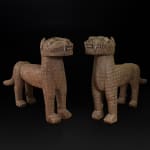Pair of Benin Royal Leopards, Eighteenth to Nineteenth Century AD
Wood, Copper
110 x 30 x 180 cm
43 1/4 x 11 3/4 x 70 7/8 in
dimensions given for each leopard
43 1/4 x 11 3/4 x 70 7/8 in
dimensions given for each leopard
GM.0110
Further images
-
(View a larger image of thumbnail 1
)

-
(View a larger image of thumbnail 2
)

-
(View a larger image of thumbnail 3
)

-
(View a larger image of thumbnail 4
)

-
(View a larger image of thumbnail 5
)

-
(View a larger image of thumbnail 6
)

-
(View a larger image of thumbnail 7
)

-
(View a larger image of thumbnail 8
)

-
(View a larger image of thumbnail 9
)

-
(View a larger image of thumbnail 10
)

-
(View a larger image of thumbnail 11
)

A superb pair of carved wooden Royal Leopards from Benin. The Oba (King) of Benin was a sacred figure for his people, a living embodiment of a powerful link between...
A superb pair of carved wooden Royal Leopards from Benin. The Oba (King) of Benin was a sacred figure for his people, a living embodiment of a powerful link between this world and the eternal one of ancestors and gods. The Oba was traditionally referred to as 'the leopard of the house' (ekpen n'owe), and representations of beautiful, majestic, and fierce leopards appear frequently in the royal art of Benin. The symbolic meaning of the royal iconography of the leopard implied two different aspects: the first was ability of the Oba to dominate wilderness with his strength, and thereby protect his people; second, the leopard embodied the fierceness and majesty of the King of Benin, who was deemed by his people to be almost supernatural figure, placed above the worldly cares and limitations of human nature.
These two leopards are skilfully carved in solid wood (the centre is not hollow, adding substantially to their solidity and weight). The leopards look forward, standing solidly on four legs, and fiercely showing their fangs. The main decoration is composed of a series of copper discs adorning the entirety of the bodies of the animals. Additional copper inlays are present around the eyes and on the junctures between the segments of each sculpture.
A very close and exceptionally prestigious, though smaller in size and possibly more recent, iconographic comparable is a couple of Nineteenth Century AD carved leopards in ivory with copper inlays presented to Britain's Queen Victoria by Admiral Sir Harry Holdsworth Rawson (AD 1843 - AD 1910) and since then in the Royal Collection of the United Kingdom and permanently loaned to the British Museum (Royal Collection Trust 69926).
References: leopards with parallel iconography can be found in the Royal Collection in London (Royal Collection Trust 69926, loaned to the British Museum).
These two leopards are skilfully carved in solid wood (the centre is not hollow, adding substantially to their solidity and weight). The leopards look forward, standing solidly on four legs, and fiercely showing their fangs. The main decoration is composed of a series of copper discs adorning the entirety of the bodies of the animals. Additional copper inlays are present around the eyes and on the junctures between the segments of each sculpture.
A very close and exceptionally prestigious, though smaller in size and possibly more recent, iconographic comparable is a couple of Nineteenth Century AD carved leopards in ivory with copper inlays presented to Britain's Queen Victoria by Admiral Sir Harry Holdsworth Rawson (AD 1843 - AD 1910) and since then in the Royal Collection of the United Kingdom and permanently loaned to the British Museum (Royal Collection Trust 69926).
References: leopards with parallel iconography can be found in the Royal Collection in London (Royal Collection Trust 69926, loaned to the British Museum).










